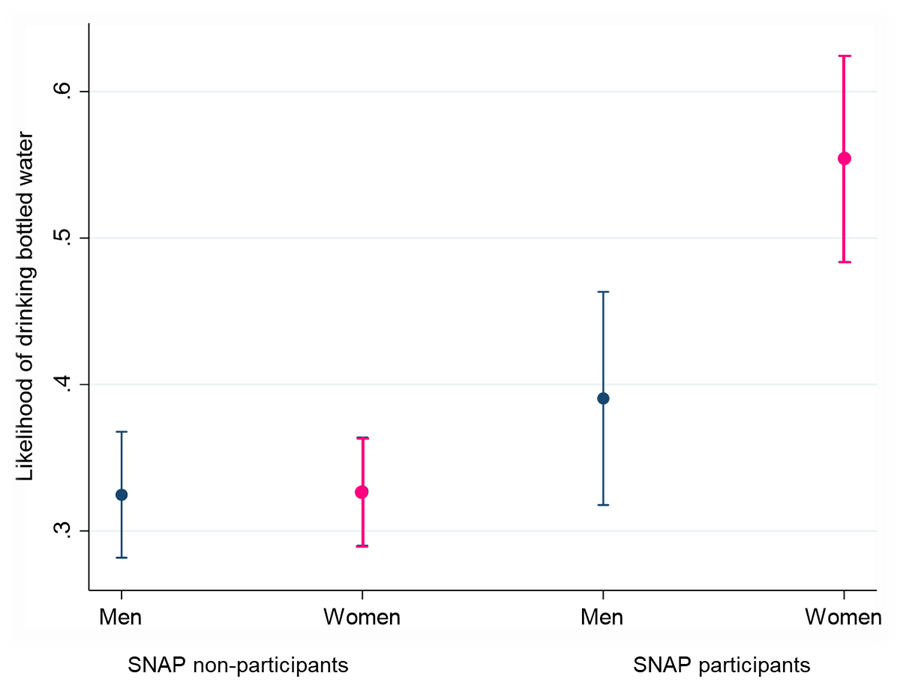The gendered pattern of water consumption among federal food assistance participants
My last post showed that there’s a gendered relationship between household income and bottled water consumption in the United States. For men, there is little or no association between income and bottled water consumption. For women, there’s a clear inverse correlation: bottled water consumption is most prevalent among low-income women, but the likelihood of a woman drinking bottled water declines as her household income increases. It’s clear that women and men perceive tap water safety quite differently, and that their choices of drinking water reflect those differences.
New data show that this gendered pattern also appears in the ways that people who participate in federal assistance programs use their benefits—with important implications for public policy.
SNAP and water
With interest groups lobbying for a permanent new federal low-income water assistance program, it’s easy to forget that the U.S. government already has a long-standing program that helps low-income Americans pay for drinking water: the Supplemental Nutrition Assistance Program (SNAP), formerly known as Food Stamps. SNAP is the country’s main food assistance program, and for decades has been one of our most effective anti-poverty initiatives.
More than 22 million U.S. households participate in SNAP, and well over a billion dollars in SNAP benefits pay for drinking water each year—but only if it’s in bottles. SNAP pays for bottled water, not utility bills. A 2016 study found that roughly 1.2% of SNAP benefits are spent on bottled water, which translates to about $1.4 billion annually.* Frequent readers of this blog know that I favor expanding SNAP to cover tap water bills as a more effective, efficient, and equitable alternative to a stand-alone federal program. Earlier this year Data for Progress (DFP) included that proposal in a national survey and found broad, bipartisan voter support for the idea.
DFP was nice enough to share their data with me, and my own analysis of their dataset found something else interesting: the use of SNAP benefits on bottled water is clearly gendered. Here’s the likelihood that an individual uses bottled water as his/her primary source of drinking water at home, by gender, for people who do and do not participate in SNAP:
Analysis of Data for Progress survey of 1,271 likely voters fielded 22-23 June 2023. Estimates adjusted for race, ethnicity, age, education, and sampling design. Thin bars represent 95% confidence intervals.
There is virtually no gender difference in bottled water consumption for people who don’t participate in SNAP—the likelihood is about 32% for both men and women. But for SNAP participants, the gender difference is stark. The likelihood that a man who receives SNAP drinks bottled water at home is about 39%, which is higher than non-SNAP participants, though not statistically distinguishable from non-participants. But for women who participate in SNAP, the likelihood of drinking bottled water jumps to 55%.
It isn’t clear from these data how much of this consumer behavior is due to perceived utility quality, premise plumbing conditions, taste and odor, or a general distrust of institutions. It is clear that low-income American women spend a great deal of their limited resources—including billions of dollars in federal assistance—on bottled water.
Implications for policy
These findings carry at least two important implications for utilities and policymakers. First, as I observed last time, low-income women make up the most critical portion of the public when it comes to building public trust in tap water. That’s a population that’s unlikely to engage actively in governance—it’s hard to find time to show up to utility board meetings when you’re barely making ends meet and maybe looking after kids or elders—so it’s incumbent on utility leaders to understand and communicate with low-income women in ways that don't involve attending meetings or listening sessions or other time-intensive processes. Do low-income women fear utility water safety? Is premise plumbing the problem? Is it aesthetics? Is it a distrust of the utility’s leaders or regulatory officials? Careful research is needed to untangle those perceptions and figure out how to address them effectively.Second, it’s clearer than ever that water affordability starts with water quality. Getting low-income women to trust tap water would free up hundreds of millions of federal dollars that are now spent on expensive, lightly regulated, and environmentally destructive bottled water.
Confident in the water that flows from their taps, women on SNAP and other assistance programs could use those limited resources to make their lives better--without more cumbersome forms, documentation, or other administrative burdens. That’s a win for taxpayers, a win for utilities, and most of all a win for women.
*Bottled water’s popularity grown steadily over the seven years, so this figure almost certainly underestimates SNAP benefits spent on bottled water.


